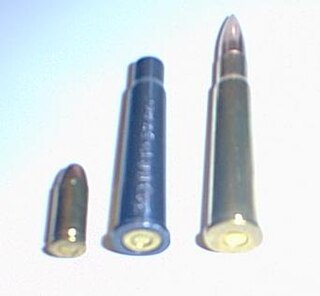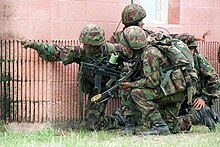
A cartridge, also known as a round, is a type of pre-assembled firearm ammunition packaging a projectile, a propellant substance and an ignition device (primer) within a metallic, paper, or plastic case that is precisely made to fit within the barrel chamber of a breechloading gun, for convenient transportation and handling during shooting. Although in popular usage the term "bullet" is often used to refer to a complete cartridge, the correct usage only refers to the projectile.

In firearms terminology, an action is the functional mechanism of a breech-loading firearm that handles the ammunition cartridges, or the method by which that mechanism works. Actions are technically not present on muzzleloaders, as all those are single-shot firearms with a closed off breech with the powder and projectile manually loaded from the muzzle. Instead, the muzzleloader ignition mechanism is referred to as the lock.

A semi-automatic pistol is a handgun that automatically ejects and loads cartridges in its chamber after every shot fired. Only one round of ammunition is fired each time the trigger is pulled, as the pistol's fire control group disconnects the trigger mechanism from the firing pin/striker until the trigger has been released and reset.
A repeating rifle is a single-barreled rifle capable of repeated discharges between each ammunition reload. This is typically achieved by having multiple cartridges stored in a magazine and then fed individually into the chamber by a reciprocating bolt, via either a manual or automatic action mechanism, while the act of chambering the round typically also recocks the hammer/striker for the following shot. In common usage, the term "repeating rifle" most often refers specifically to manual repeating rifles, as opposed to self-loading rifles, which use the recoil, gas, or blowback of the previous shot to cycle the action and load the next round, even though all self-loading firearms are technically a subcategory of repeating firearms.

A gun barrel is a crucial part of gun-type weapons such as small firearms, artillery pieces, and air guns. It is the straight shooting tube, usually made of rigid high-strength metal, through which a contained rapid expansion of high-pressure gas(es) is used to propel a projectile out of the front end (muzzle) at a high velocity. The hollow interior of the barrel is called the bore, and the diameter of the bore is called its caliber, usually measured in inches or millimetres.
Internal ballistics, a subfield of ballistics, is the study of the propulsion of a projectile.
Blowback is a system of operation for self-loading firearms that obtains energy from the motion of the cartridge case as it is pushed to the rear by expanding gas created by the ignition of the propellant charge.

A breechblock is the part of the firearm action that closes the breech of a breech loading weapon before or at the moment of firing. It seals the breech and contains the pressure generated by the ignited propellant. Retracting the breechblock allows the chamber to be loaded with a cartridge.

Gas-operation is a system of operation used to provide energy to operate locked breech, autoloading firearms. In gas-operation, a portion of high-pressure gas from the cartridge being fired is used to power a mechanism to dispose of the spent case and insert a new cartridge into the chamber. Energy from the gas is harnessed through either a port in the barrel or a trap at the muzzle. This high-pressure gas impinges on a surface such as a piston head to provide motion for unlocking of the action, extraction of the spent case, ejection, cocking of the hammer or striker, chambering of a fresh cartridge, and locking of the action.

Rotating bolt is a method of locking the breech of a firearm closed for firing. Johann Nicolaus von Dreyse developed the first rotating bolt firearm, the "Dreyse needle gun", in 1836. The Dreyse locked using the bolt handle rather than lugs on the bolt head like the Mauser M 98 or M16. The first rotating bolt rifle with two lugs on the bolt head was the Lebel Model 1886 rifle. The concept has been implemented on most firearms chambered for high-powered cartridges since the 20th century.

A bolt is the part of a repeating, breechloading firearm that blocks the rear opening (breech) of the barrel chamber while the propellant burns, and moves back and forward to facilitate loading/unloading of cartridges from the magazine. The firing pin and extractor are often integral parts of the bolt. The terms "breechblock" and "bolt" are often used interchangeably or without a clear distinction, though usually, a bolt is a type of breechblock that has a nominally circular cross-section.

Locked breech is the design of a breech-reloading firearm's action. This is important in understanding how a self-reloading firearm works. In the simplest terms, the locked breech is one way to slow down the opening of the breech of a self-reloading firearm when fired. The source of power for the movement is recoil.

A caliber conversion sleeve or adapter sleeve is a device which can be used to non-permanently alter a firearm to allow it to fire a different cartridge than the one it was originally designed to fire. The different cartridge must be smaller in some dimensions than the original design cartridge, and since smaller cartridges are usually cheaper, the device allows less expensive fire practice.
A muzzle booster or recoil booster is a device fixed to the muzzle of a firearm, intended to harness the energy of the escaping propellant to augment the force of recoil on portions of the firearm. In spite of its name, a muzzle booster does not increase muzzle force or velocity but instead is usually used to improve the reliability and/or rate of fire of a recoil operated firearm. It was invented by Hiram Maxim in 1894.

The OTs-33 Pernach is a Russian 9x18 Makarov machine pistol, derived from the 5.45 mm OTs-23 Drotik machine pistol. The Pernach is an automatic pistol designed to replace the Stechkin APS in various special OMON units within the Russian police, the Russian Ministry of Internal Affairs (MVD) and other paramilitary units. The OTs-33 was developed in 1995 by Igor Stechkin at the TsKIB SOO design bureau, and it went into limited production at the KBP Instrument Design Bureau. It is also known as the SBZ-2, derived from the names of the KBP team responsible for the pistol, namely Stechkin, Baltser (Бальцер) and Zinchenko (Зинченко).
The StG 45(M) (abbreviation of Sturmgewehr 45, "Assault Rifle 45") sometimes referred to as the MP 45(M), was a prototype assault rifle developed by Mauser for the Wehrmacht at the end of World War II, using an innovative roller-delayed blowback operating system. It fired the 7.92×33mm Kurz (or "Pistolenpatrone 7.9mm") intermediate cartridge at a cyclic rate of around 450 rounds per minute.
The following are terms related to firearms and ammunition topics.

The MG 45 was a machine gun based on the MG 42, which was developed but not fielded in significant numbers by the German Army in World War II.

Blow forward is a firearm action where the propellant gas pressure and the friction of the bullet traveling down the bore drag the whole gun barrel forward to facilitate the opening of the breech. This forward barrel motion provides most of the energy required to eject a spent cartridge case and chamber a fresh round of ammunition, and contains a minimum of moving parts, and thus is more compact than other operating mechanisms of equal barrel length.
Recoil operation is an operating mechanism used to implement locked-breech autoloading firearms. Recoil operated firearms use the energy of recoil to cycle the action, as opposed to gas operation or blowback operation using the pressure of the propellant gas.

















